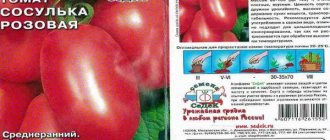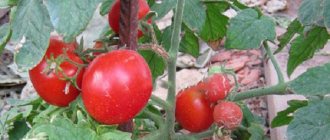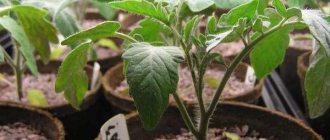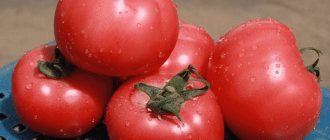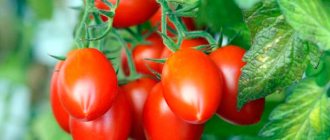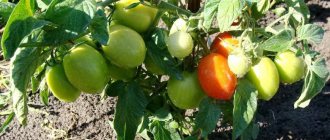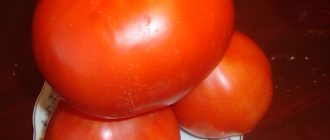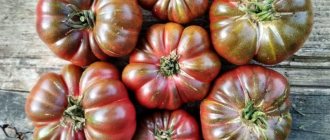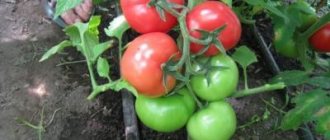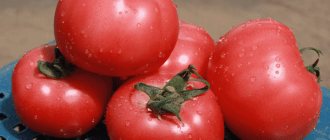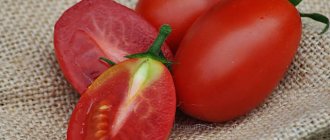The variety of pink tomatoes is so great that you are often at a loss as to which one to choose. The Pink Stella variety definitely stands out from many others due to the taste of its fruit. Ripe raspberry-colored vegetables are saturated with vitamins B and C. A small percentage of acidity allows the fruits to be used for baby and dietary nutrition. Small compact bushes will decorate any summer cottage. The culture is so easy to care for that it is recommended even for novice gardeners.
This article presents photos and descriptions, characteristics and reviews of the Pink Stella variety.
Characteristics and description of the variety
The Pink Stella tomato variety was bred by Altai breeders and is intended for breeding in warm regions, but is successfully grown in areas with temperate and cold climates. It takes root equally well both in greenhouse conditions and in open beds.
Distinctive features
Determinate type, standard, compact, 50-60 cm high .
The foliage is medium, the leaves are elongated, dark green. One cluster bears 6-7 fruits; clusters are formed frequently, every other leaf. Mid-early variety , 105-110 days pass from the moment of sowing the seeds to full ripening.
The yield is excellent , up to 3 kg of fruit is harvested from 1 seedling, provided that 3 plants are planted per 1 sq. m. m.
The culture's immunity includes high resistance to most insect pests and diseases characteristic of the nightshade family.
Low-growing bushes do not require pinching, but you cannot do without a garter: the fruit-bearing branches cannot support the weight of ripe vegetables.
Fruit characteristics
The average weight of one tomato is 170-180 g, the shape is pepper-shaped , elongated, the color is pink-raspberry. The taste is pronounced, sweet-dessert with barely noticeable sourness, the flesh is juicy. The peel is thin but dense, cracking in dry weather with a lack of moisture. There are 4 seed chambers, few seeds.
The purpose of tomatoes is universal : they are used fresh and for winter preparations. Suitable for processing into tomato products. Ripe tomatoes make excellent juices, not only canned, but also freshly squeezed.
The photo shows Pink Stella tomatoes.
Tomatoes Pink Stella on video
Seed producer : agricultural company Siberian Garden.
If you grew Pink Stella tomatoes, please write whether you liked them or not. What was the yield and taste of the fruit? Will you grow them again? How do you rate the disease resistance of this tomato? If possible, attach to your review a photo of the entire bush as a whole or individual fruits you grew. Thank you!
Your reviews of the Pink Stella tomato and additions to the description will help many gardeners evaluate this variety objectively in order to decide whether it is worth growing or not.
This is a natural variety of tomato. Therefore, we recommend taking seeds from a ripe fruit and using them for planting in subsequent seasons.
How to grow seedlings
Seeds for seedlings begin to be sown 2 months before planting in the ground . The seed material is collected independently, since the variety is not a hybrid, which means that the varietal advantages are preserved in the next generation.
Seed preparation
The seeds are laid out on the table and carefully inspected for visible damage. Suitable specimens must be light-colored and free of distortion. They are then immersed in a saline solution for 10 minutes. This is how they check whether the grains are empty or not. Those that have floated to the surface are not suitable for landing. Afterwards, the grain is disinfected in a weak solution of pinkish potassium permanganate for 20 minutes. Then rinse with running water and dry.
To improve germination, seeds are soaked in a growth stimulator for 12 hours.
Reference. In addition to specialized drugs, melt water or aloe juice are used as growth stimulants.
Container and soil
The soil is prepared from turf soil, peat and humus in a ratio of 2:2:1 .
All components are thoroughly mixed and the resulting mixture is disinfected by heating in the oven for 15 minutes at a temperature of 50°C. Another way is to spill the soil with a hot solution of potassium permanganate. After the soil has cooled , it is laid out in planting containers, having previously made small drainage holes at the bottom where excess moisture will drain.
Planted in a common wooden box or individual containers . Plastic cups and peat pots are the most common and convenient way to propagate seedlings, because when planted in a separate container, seedlings grow and develop better. In addition, plastic containers are lightweight, which does not cause difficulties when transporting planting containers to a summer cottage.
Reference. Disinfected soil is the key to healthy and strong immunity of seedlings.
Sowing
Seeds are sown in grooves 1 cm deep at a distance of 1-2 cm from each other . Sprinkle the soil on top, level it and lightly moisten it with warm, settled water. Then the containers are covered with film or glass to create a greenhouse effect and left in a warm room at a temperature of 23-24°C. The film is periodically removed for ventilation and the top layer of soil is moistened as necessary.
Growing and care
1 week after sowing, the appearance of the first shoots is noticeable . The film is removed and the containers are placed on the windowsill, but not in direct sunlight. The duration of daylight should be at least 14 hours, so there is a need for additional lighting with fluorescent lamps.
Reference. Direct exposure to sunlight can cause burns to young plants.
Water as the top layer of soil dries along the edge of the nursery with warm, settled water using a shallow watering can. After watering, the soil is loosened superficially, without touching the young roots.
The room temperature during the seedling period is maintained at 22°C, and the night temperature should not fall below 16°C.
There is no need to water abundantly , as the sprouts will begin to stretch, which is undesirable in the initial period. To ensure that the seedlings grow straight, they are periodically turned to the window in different directions.
About other varieties of pink tomatoes:
A variety with amazing taste - Raspberry Giant tomato
Early ripe tomatoes for juices, salads and canning “Fatima”
Mid-season variety with fruits, like from the picture - “Major” tomato
After 2-3 true leaves appear, the seedlings are planted , planted in separate containers. After picking, the seedlings intensively grow their root system, which has a beneficial effect on plant growth.
2 weeks before planting in the ground, seedlings begin to harden by taking them outside during the day for 1 hour at a temperature of 17-18°C. Gradually, the time spent outdoors is increased to 12-14 hours. Simultaneously with daytime hardening, the night temperature in the room is reduced to 13°C.
5 main mistakes when growing tomato seedlings
Rules for planting and care
The Pink Stella tomato variety is grown in seedlings. Seeds are collected independently or purchased from a retail chain.
Do-it-yourself envelope - what materials can you use to make a stylish envelope (110 photos)
Growing seedlings
Sowing of seeds is carried out 2 months before selecting seedlings for further growing season. In temperate climates - approximately in mid-March, in the southern regions - 10 days earlier. Sequence of work:
- Prepare a planting mixture in equal proportions from peat, river sand, and topsoil from a permanent location.
- Take containers: wooden boxes or plastic containers, at least 15 cm deep.
- Pour in the nutrient mixture, make 1.5 cm furrows, and plant seeds at a distance of 0.5 cm.
- Water with warm water and fall asleep.
- The top of the container is covered with glass, transparent polycarbonate or plastic film.
- Place in a room with a temperature of +230 C.
After the sprouts appear, the covering material is removed, the containers are placed in a lighted place, and fed with complex fertilizer. Water every 2 days with a small amount of water.
After the formation of 3 leaves, the tomato planting material is planted into plastic or peat cups. 7 days before planting in the ground, the plants are hardened off and the temperature is gradually lowered to +180 C.
Tomato care
Tomatoes of the Pink Stella variety require standard agricultural technology:
- The plants are fertilized for the first time during flowering with ammonia. Secondly, at the time of fruit growth, phosphorus-containing fertilizers are applied, and during the period of technical ripeness of tomatoes, organic matter is added to the root.
- The variety requires watering; it is carried out 2 times every 7 days, subject to dry summers. Tomatoes growing in open ground should be watered early in the morning or after sunset.
- The bush is formed into 3 or 4 shoots, the remaining stepsons are removed, excess leaves and fruit-bearing clusters are cut off, a support is installed, and the plant is tied up as it grows.
- For preventive purposes, the plant is treated with copper-containing preparations at the time of fruit set.
After planting, the root circle is mulched with compost; organic matter acts as a moisture-retaining element and additional fertilizing.
Transplanting seedlings
Tomatoes are planted in an open area after the soil has warmed to 150 C at the end of May, and in a greenhouse - in mid-May. Planting pattern:
- Make a recess in the form of a furrow of 20 cm.
- Compost is poured at the bottom.
- Tomatoes are placed vertically.
- Cover with soil, water, and mulch.
3 tomatoes are planted per 1 m2, row spacing is 0.7 m, the distance between bushes is 0.6 m. The planting pattern for the greenhouse and the unprotected area is the same.
How to grow tomatoes
After 55-60 days, the seedlings are ready for planting in the ground . Seedlings are planted in open beds 2 weeks later than in greenhouse conditions. By the time of transplantation, the soil should be warmed to 16-17°C.
Landing
Before planting tomatoes, the soil is treated with copper sulfate at the rate of 1 tablespoon per 1 bucket of water to prevent fungal diseases. Then the soil is dug up with the application of mineral fertilizers.
Planting pattern : 40 cm – distance between seedlings, 60 cm left between rows. For 1 sq. m place 3 plants. Planted in holes 20 cm deep, at the bottom of which a little wood ash is first placed. After transplantation, the holes are compacted, watered with warm, settled water and the young bushes are left to adapt to the new conditions for 9-10 days. During this period, the plants are not watered or fed.
Further care
Regular watering is established no more than 2 times a week . The best time for watering is evening or early morning. Water with warm water, under the root, without getting on the leaves. Sprinkling is not recommended, since in addition to sunburn, plants can develop blossom-end rot. On dry days, the amount of watering is increased. The crop also consumes more moisture during fruit formation.
Reference. Sprinkling is a method of irrigation in which water, often with the help of special devices, is sprinkled in the form of rain over the soil surface and plants.
After watering, the ground is loosened, removing weeds with roots . Loosening saturates the root system with oxygen and disrupts the usual habitat of many pests living in the ground.
Hilling, like loosening, promotes better penetration of oxygen and strengthens the rhizomes, resulting in the formation of a strong stem. Hilling is carried out no more than 3 times during the season. This is quite enough to form a full-fledged stem.
Throughout the growing season, the crop is fed 4 times.:
- The first fertilizing is applied 3 weeks after transplantation. Fertilizers - “Ideal” and “Nitrophoska”. 1 tbsp. l. dissolve in 1 bucket of water and pour 0.5 liters under the bush.
- During flowering, apply a second fertilizing with Signor Tomato fertilizer at the rate of 1 tbsp. l. for 1 bucket of water. For each seedling, 1 liter of solution is used.
- The third feeding is applied 10-12 days after the second. Fertilize with “Ideal” and “Nitrophoska” in the same proportions as the first time.
- Fertilize with superphosphate for the fourth time. The solution is prepared from 1 tbsp. l., diluted in 1 bucket of water. For 1 sq. m consume 10 liters of solution.
Features of care and possible difficulties
Low-growing bushes do not require pinching . They are formed into 3 or 4 stems, all other shoots are removed. The plant does not throw out side shoots in the future, so they are not pruned. Large leaves that block the penetration of sunlight are cut off. Also remove those branches that have stopped bearing fruit.
For gartering, a wooden or metal support is installed next to each bush during transplantation , to which the stem is fixed. Immediately after transplanting, tie the stem so that it grows evenly. In the future, fruit-bearing branches are also fixed to the support, since they cannot support the weight of ripe vegetables.
Diseases and pests
The culture is distinguished by strong immunity to tobacco mosaic virus and late blight . But it is susceptible to attacks by the Colorado potato beetle, which cause irreparable harm to plants. In addition, females lay eggs on the back of the leaves, which cannot be noticed unless the leaves are turned over when inspecting the plants. Colorado potato beetle larvae are no less dangerous than adult individuals.
To scare away this pest, mustard bushes are planted next to the tomatoes . Their pungent smell irritates many insects, and they try not to approach such beds. If the insect managed to reproduce in large numbers, use the drug “Prestige”. Otherwise, all the leaves will be eaten and the crop will die.
Attention! The most effective preventive method is regular inspection of seedlings for changes due to disease or the presence of insect pests. It is always easier to prevent any problem than to deal with it later.
The best varieties of Siberian selection
The final choice of variety for planting always depends on the gardener himself. Only he decides what is more important to him: getting large or early fruits, focusing on taste and sugar content, or choosing a variety that requires minimal care. Therefore, it is most convenient to choose a tomato from a certain category.
High-yielding
High-yielding tomatoes of Siberian selection include the following varieties and hybrids: Abakan pink, Alsou, Scarlet candles, Grandmother's secret, Bull's forehead, Great warrior, Velmozha, Pride of Siberia, Goose egg, Pride of Siberia, Demidov, Golden domes, King of giants? King of Siberia, Malachite Box, Monastery Meal, Sensei.
On a note! From 1 sq. m of planting area, with proper agricultural technology, you can harvest up to 25 kg of productive varieties of tomatoes.
Precocious (early)
Such a quality as the early ripening of tomatoes is most often combined with the compact shape of the bushes, because determinate varieties require less time to develop and grow green mass. Ultra-early ripening and early varieties of Siberian selection include: Alsou, Velvet Season, White Naliv, Berdsky Krupny, Bulat, Velmozha, Vivido-Invisible, Ground Gribovsky, Lady's Fingers, Demidov, Dubok, Countryman, Sugar Bison.
All of the listed varieties have become famous far beyond their region and are now grown by gardeners throughout Russia. Most of them can be planted both in a greenhouse and in open ground.
Large-fruited
Large-fruited tomatoes are often grown in a greenhouse. Greenhouse conditions allow the vegetable to gain weight and ripen faster. The large-fruited group includes varieties that produce fruits weighing 250 g or more. The category of tomatoes that produce giant fruits, bred in Siberia, includes the following: Abakan pink, Bull's forehead, Great warrior, Pride of Siberia, King of giants.
On a note! Due to the heaviness of the fruit, such tomatoes require a mandatory garter to a support, otherwise the shoots may break. These tomatoes also need to be fed more often.
The taste of tomatoes is especially important if they are grown for fresh consumption. The increased sugar content makes tomatoes sweet; even children will like these fruits. The following Siberian tomatoes are famous for their sugary pulp: Watermelon, Alsou, Velmozha, Lemon Giant, Golden Koenigsberg, Sensei, Favorite Holiday, Princess, Pink Honey, Pink Stele, Pink Flamingo, Siberian Troika, Chocolate Miracle, Bread and Salt, Miracle of the Earth.
Sweet tomatoes are perfect for preparing salads and other dishes. The fruits of some varieties can be eaten even without salt, their taste is so harmonious.
Troika and Siberian troika - productive Siberian varieties of tomatoes: video
Carpals
Raceme tomatoes are hybrids. All fruits are approximately the same size, look even and attractive. Ripe tomatoes can be picked directly with a brush, which makes harvesting and further transportation easier. A ripe cluster can remain on the bush for another month without losing the quality of the fruit. Among the raceme tomatoes of Siberian selection, the most famous are: Bull's forehead, King of Siberia, Rugby, Siberian abundant.
Carpal tomatoes are able to resist fruit cracking even in the case of improper care or unsuitable weather conditions. These hybrids are usually famous for their increased productivity and good immunity.
short
Low-growing (determinant) tomato varieties are ideal for growing in open ground. Such tomatoes form a powerful bush that successfully withstands winds and does not require the use of support; they do not need to be pinched, which makes care much easier. Due to the fact that adult plants form in a shorter period of time, the harvest on these tomatoes ripens earlier than usual.
Today, the following low-growing tomatoes bred by Siberian breeders are popular among summer residents: Buyan, Vasya-cornflower, Danko, Zemlyak, Kubyshka, Nikola, Metelitsa, Petrusha Ogorodnik, Slivovka, Heavyweight of Siberia, Ultra-early.
The height of the bush of low-growing tomatoes does not exceed 40-60 cm. If you remove the stepsons, the size of the fruit will be larger, but many summer residents are quite happy with small vegetables, which are convenient to roll into jars.
The most productive Siberian tomato varieties: video
Residents of Siberia today can easily boast of their own tomato harvest. Every year new and improved varieties for this region appear on the market. Their abundance allows you to choose tomatoes for every taste and for any growing method.
The nuances of breeding in open ground and in a greenhouse
The culture is intended for cultivation in open ground and in greenhouse conditions . The height of greenhouse plants is practically no different from street plants; they are just as low and compact. Temperature changes do not affect the quantitative indicator, since the tomato is adapted to lower temperatures.
The culture is demanding on lighting, starting from the seedling period . With a lack of light, young plants stretch out, and later in shaded places ripening occurs later, and small fruits are formed.
Moderate watering is necessary to prevent ripe vegetables from cracking . If the plant is not watered for a long time in dry weather, and then immediately watered abundantly, an excess of moisture will negatively affect the taste and quality of the tomatoes.
Ideal predecessors of tomatoes are winter or legume crops, carrots, cabbage, and cucumbers. Crop rotation rules strongly recommend not to plant tomatoes in the place where crops from the nightshade family previously grew. They pull most of the nutrients from the soil, so the tomato will experience a constant lack of beneficial microelements in depleted soil.
What varieties of tomatoes should I choose for planting?
DenisNata, Shutterstock.com
Which tomatoes should you choose to grow on your plot? How not to get confused with such a variety that is offered in specialized seed stores? So many varieties and hybrids!
If buying seeds and planting seedlings is new to you, then ask your fellow gardeners for advice. If a variety is mentioned commendably by many, feel free to take note of it. And carefully study the information on seed packages.
When purchasing, pay attention to what type of tomatoes - for greenhouses or open ground. Sometimes they ask whether it is possible to plant tomatoes adapted for cold regions in the southern regions or in central Russia. Experienced gardeners believe: if in Siberia this variety gives a good harvest and withstands the vagaries of the climate, then in the south it is even more so. I propose to get acquainted with the varieties and hybrids that are most popular among the people and have been tested in various regions
But which one to choose is up to you. It depends on which ones you like and for what purposes you will use them. – hybrid, mid-early – from 100 to 105 days, cultivation – universal. The fruits are sweet, round in shape, pinkish in color.
The size is large. Use - both for salads and canning. - This is a hybrid, with a growing season of 85-100 days. Suitable for greenhouses and open ground. The plant is 150 cm high. The fruits are sweetish in taste, heart-shaped, red in color.
The fruit size is average. Good for salads. – from mid-early varieties. Siberian selection. The height of the plant is small, up to 80 cm. For universal cultivation.
The yield is good (up to 9 kg per 1 sq.m.) The tomatoes are large - from 500 g, tasty, red in color. – an early ripening hybrid, it has a growing season of 85–100 days. Universal type. The height of the bush is between 50–100 cm, the tomatoes are large, bright red, round in shape, with sourness.
Good for salads and pickles. – mid-early variety. Vegetation period - from 100 to 110 days. The growth of the bush is up to 150 cm. The variety is used for open ground. This famous variety has large pink fruits with a sweetish taste.
Universal use. – mid-season variety, with a vegetative period of 110–115 days. Can be grown in open ground and in greenhouses. Height - up to 100 cm. Tomatoes are large, round in shape, red in color.
With sourness. Use – universal. – early ripening variety, for outdoor planting, growing season – 85–100 days. Bush height 60 cm. Productive.
The variety is resistant to diseases. The tomatoes are large, about 300 g, tasty. Universal use. – early ripening variety (vegetative period 85–100 days), for open ground and greenhouses, not demanding on agricultural technology.
This variety has a short height, about 50-60 cm, and does not require pinching. Tomatoes weighing up to 80 g, sweet and sour taste, dense. Universal use – the name is familiar to everyone, grapes with this name are the favorite fruit of many.
Tomato fingers are also popular among gardeners. The variety is early ripening (90–100 days). Can be grown in greenhouses and open ground. Bushes are about 80 cm. Fruit weight is up to 70 g, red.
Good for canning. – super-early variety. Bred by Siberian breeders, with adaptation to cold regions, resistant to frost and disease. Plant height 70 cm, can be grown without pinching.
The yield is excellent - in a cluster there are up to 15-17 plum-shaped fruits, weighing up to 80 g, can be used both in salads and for canning. - mid-early variety, universal cultivation. About 50 cm high.
Tomatoes are pink-raspberry in color, average weight up to 200 g, sweet taste. Good for salads. – an ultra-early ripening variety popular among gardeners, the ripening period is 80–90 days, suitable for greenhouses and open ground. Productivity is high. Bush height up to 50 cm.
The tomatoes weigh about 130 g, tasty and dense. Universal use - for canning and fresh consumption. – early ripening variety. Vegetation period – 98–105 days.
Small height of the bush. Productivity up to 6 kg per 1 sq. m. Excellent taste, fruits up to 115 g, round in shape, red in color. – the variety is popular among the people for its excellent taste. Medium early ripening, grown both in open ground and in greenhouses.
Excellent fruit set. Plant height is within 100 cm. Good yield - 5 kg per bush. The fruits weigh up to 250 g maximum, similar in shape and color to persimmons, sweet and fleshy.
They are used universally - both in salads and for canning. I hope this small list of tomato varieties and hybrids will help someone make their choice in a seed store. Have a good harvest!
Harvesting and application
Harvesting begins in late July - early August and, thanks to long fruiting, continues until the first frost. Ripening is not smooth; the last tomatoes are picked green. They ripen well at home, while in the garden beds at this time the risk of fungal diseases increases.
The purpose of tomatoes is universal : they are used to prepare a variety of dishes, from the simplest summer salads to hot and vegetable dishes. Ripe vegetables make excellent freshly squeezed and canned juices, where the characteristic sourness of tomatoes appears. Also, tomatoes do not lose their taste in barrel pickling, marinades and processed tomato products: ketchups, pastes, lecho, adjika.
Main diseases and ways to combat them
In general, the fruits of the “Pink Stella” variety are little susceptible to the most common “tomato” ailments. To increase plant resistance to diseases, prevention is recommended. Before transplanting young tomatoes into the soil, it is spilled with water with the addition of copper sulfate or potassium permanganate.
The plant is sometimes affected by late blight. In this case, the affected tomato sprouts are destroyed, after which it is treated with copper-containing compounds. To defeat gray or brown rot, you should loosen the soil more often and do not water it abundantly.
You can fight spider mites on tomatoes using insecticides that are sold in specialized stores.
If whiteflies, spider mites or thrips appear on tomatoes, industrial insecticidal preparations are used to combat them. Spraying the bushes is carried out 2-3 times every 3 days, achieving complete cure for parasites.
Naked slugs will disappear after treating the stems with ammonia. To kill aphids, plants are shed with warm water and laundry soap diluted in it.
Advantages and disadvantages of the variety
The variety has many positive characteristics:
- low growing bushes;
- ease of care;
- adaptation to any weather conditions;
- does not require pinching;
- persistent immunity to diseases;
- excellent yield;
- excellent taste of fruits;
- long fruiting;
- versatility in cooking;
- long storage;
- long transportations.
The negative aspects include the obligatory garter and a constant moderate watering regime, otherwise the skins of the vegetables will crack.
Farmer reviews
Several reviews from gardeners who prefer this crop to other varieties of tomato.
Natalya, Magnitogorsk : “My favorite variety. I have been planting it for many years and will never give up. Unpretentious and disease-free, not afraid of bad weather, always produces abundant fruit. It is universal in cooking, the fruits are beautiful and tasty. I recommend it to everyone."
Vladimir, Samara : “I saw the tomato for the first time in photographs, I was impressed by its low growth and excellent yield. I grew it in open ground and collected almost a bucket of delicious vegetables from 1 seedling. I especially liked the canned food and fresh salads.”
New varieties of Siberian selection for 2021
On the websites of Siberian agricultural companies you can find new varieties of tomatoes for 2021. Here are the new products that the presenters and Agros offer to gardeners:
- Wolf Fang. An early ripening variety for growing in open ground. The ripening period lasts 100-105 days from the moment of emergence. A high-yielding variety with a friendly yield. The tomato is resistant to low temperatures. The maximum height of the bushes is 60 cm. The fruits are heart-shaped, with glossy red skin. The pulp is sugary. Fruit weight 120-170 g. A universal purpose tomato.
- Queen of beauty. Hybrid for greenhouses with early ripening. The fruits are oval in shape and covered with shiny crimson skin. The plant is indeterminate, up to 190 cm high. The fruits are collected in clusters, their average weight is 150-180 g. The pulp is dense, sweet and sour, with a small number of seeds. The variety is suitable for fresh consumption, juicing, and canning.
- Nightingale the robber. An early ripening variety, suitable for any growing method. Forms a bush up to 60 cm high. Does not require pinching or staking. The tomato is weather resistant. The fruits are round in shape, covered with pink skin, their average weight is 150 g. The variety has a universal purpose.
- King of the hill. A variety with medium ripening periods. The bush grows up to 1 m in height. The large, crimson-colored fruits have a flat shape and weak ribbing. The weight of tomatoes can be from 300 to 600 g. The pulp is fleshy, sugary, and has almost no seeds. The variety is used for fresh consumption and cooking.
- Novosibirsk red. An early ripening variety for open ground in the northern regions. Medium-sized bushes, cubic in shape. The average fruit weight is 90 g. The skin is red and dense. The tomato has good immunity and is resistant to low temperatures. The variety is characterized by high productivity and forms ovaries in a friendly manner. Tomatoes can be canned and eaten fresh.
When choosing a new variety of tomatoes, the gardener gives himself a surprise. After all, there are no reviews on these tomatoes yet, and everyone can try them for themselves and see whether they suit him or not.
